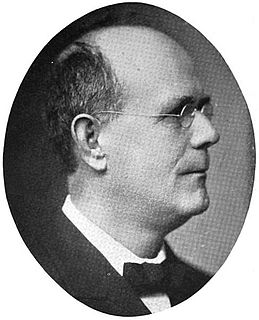
William Alfred Quayle was an American Bishop of the Methodist Episcopal Church, elected in 1908.
Charles Wesley Brashares (1891–1982) was an American bishop of The Methodist Church and the United Methodist Church, elected in 1944.

Elijah Embree Hoss, Sr was an American bishop of the Methodist Episcopal Church, South, elected in 1902. He also distinguished himself as a Methodist pastor, as a college professor and administrator, and as an editor.

Arthur James Moore was an American bishop of the Methodist Episcopal Church, South (MECS), the Methodist Church, and the United Methodist Church, elected in 1930.
Clare Purcell was an American bishop of the Methodist Episcopal Church, South and the Methodist Church, elected in 1938.

John Wesley Hardt was an American bishop of the United Methodist Church, elected in 1980. He also distinguished himself as a preacher and a pastor of Methodist Churches, as a district superintendent, and as an author and biographer.
John Louis Nuelsen was a German-American Bishop of the Methodist Episcopal Church and The Methodist Church, elected in 1908. He also distinguished himself as a Methodist pastor, as a college and seminary professor and theologian, and as an author and editor.

Edward Gonzalez Carroll was an American bishop of the United Methodist Church, elected in 1972.
Frederick Buckley Newell was an American bishop of The Methodist Church, elected in 1952.
Alexander Preston Shaw was notable as an African-American pastor, editor, and bishop of the Methodist Episcopal Church and the Methodist Church. He was elected and consecrated to the episcopacy in 1936. Shaw held the distinction of being the first African-American bishop of the Methodist Church to preside full-time over a predominantly white Annual Conference: the Southern California-Arizona Conference, which met that year at the University of Redlands.

Prince Albert Taylor Jr. was an American bishop of The Methodist Church and the United Methodist Church, elected in 1956. When he died he held the distinction of the longest tenure of all living United Methodist Bishops at that time. Only one other Bishop remained from those elected in 1956: Bishop Ralph Edward Dodge. And as it happened, Bishop Dodge was but two days older than Bishop Taylor! No other Bishops elected before 1956 were alive in 2001. Bishop Taylor was also one of only three remaining African American Bishops elected by the Central Jurisdiction of The Methodist Church. The others were James Samuel Thomas and L. Scott Allen.
Robert Hitchcock Spain is an American retired bishop of the United Methodist Church, elected in 1988.
Roy Hunter Short was an American bishop of The Methodist Church and the United Methodist Church, elected in 1948.
John Monroe Moore was a bishop of the Methodist Episcopal Church, South, elected in 1918.
William Angie Smith was a bishop of The Methodist Church and the United Methodist Church, elected in 1944.

Lloyd Christ Wicke (1901–1996) was an American bishop of The Methodist Church and the United Methodist Church, elected in 1948. When he died in 1996 he was the oldest of the 117 active and retired United Methodist Bishops at that time, as well as the last one elected during the decade of the 1940s.
Raymond LeRoy Archer, was an American bishop of The Methodist Church. He was elected in 1950.
William Turner Watkins was an American bishop of the Methodist Episcopal Church, South (MECS) and of The Methodist Church, elected in 1938. He also distinguished himself as a Methodist pastor, as a university professor, and as an editor.

John W. Gowdy was a Scottish American bishop of the Methodist Episcopal Church and The Methodist Church, elected in 1930. He also distinguished himself as a missionary, an educator, and as a college and university president.

Methodist views on the ordination of women in the rite of holy orders are diverse.



